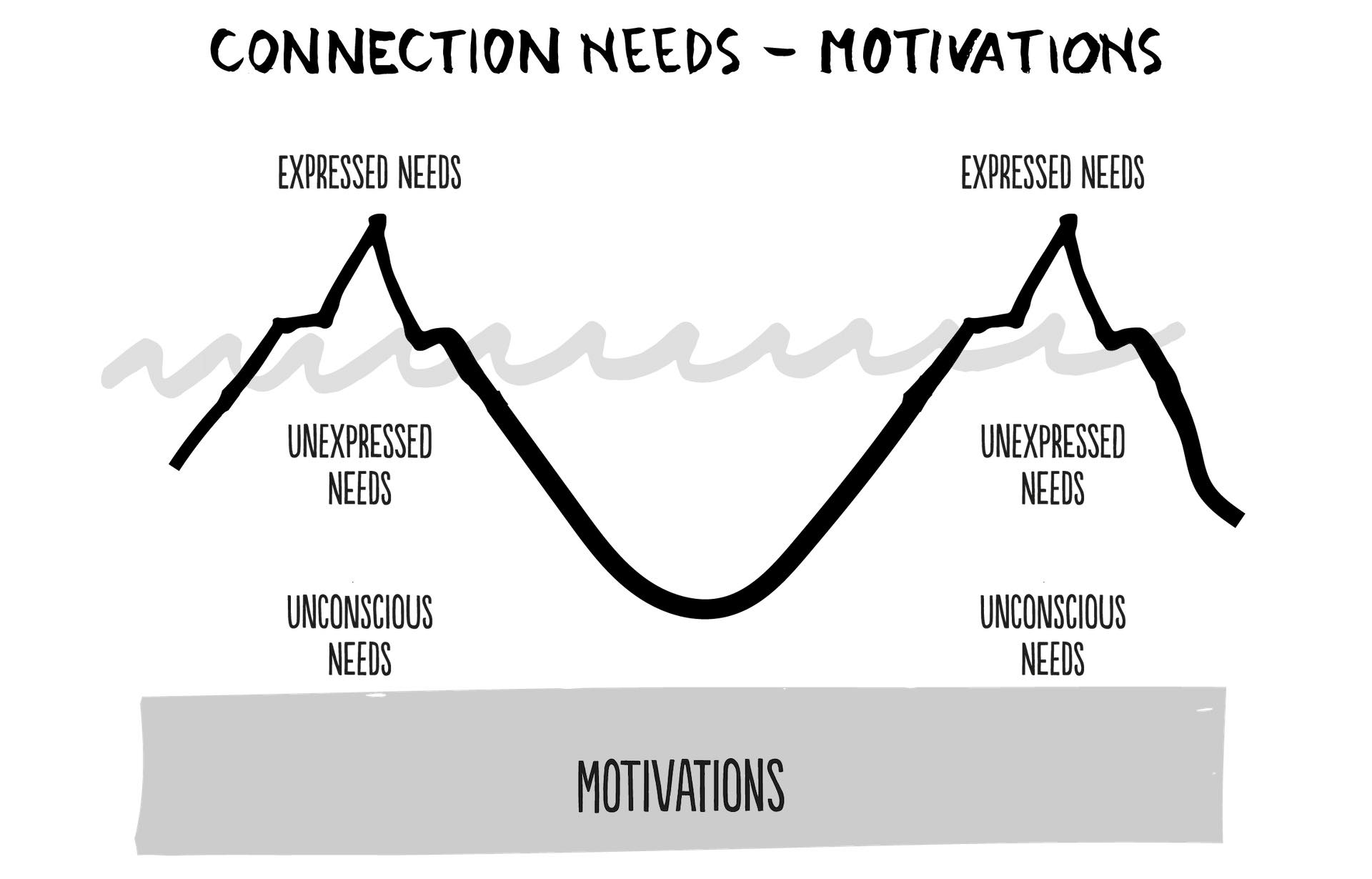Reading time: 5 min
Any good salesman knows that one decisive strategy to get the sale is fully understanding what the customers need. Nothing new up to here; however, talking about needs in general is limiting and could lead you astray. In this article we will introduce you to methods and tools to explore the complex world of customer motivations in order to unleash their ability to choose and guide them towards maximum satisfaction, certain that a happy customer is the key to success.
Material needs and psychological needs
Let’s clarify what happens in the consumer’s mind at the time of purchase. The potential customer gets in contact with the seller because he/she “needs something”, has a “problem to solve”, a desire or in any case wants to achieve a result. We will define as need what the customer requires to satisfy his/her concrete, material need. A need therefore responds to the question “what do you need?”.

As can be seen in the iceberg image, only a small part of the needs is expressed immediately and clearly by the customer. The seller must be able to build a relationship of trust that leads the customers to express even those needs they didn’t declare out of modesty or insecurity.
Precise questions and empathy help bring out even the most hidden or unconscious desires and needs.
However, the picture is not yet complete. As behavioral economics teaches us, all human beings move in the world and make choices guided by profound values, which represent what they believe in and act as a push to motivate them to act; they answer the question “why do you need it?”. In order to fully satisfy the customer, the seller also needs to understand these reasons, which we could define as psychological needs aka motivations.
Within a Sales Ethics, that really aims at creating shared value, we suggest you to consider the sum of needs + purchasing motivations as the real objectives of the customer.
Just how do you understand the material and psychological needs considering that in the world there are so many different customers?

The 10 purchasing motivations
In our research on Sales Ethics we have identified 10 prevailing purchasing motivations that you can find listed below. Through questions and listening we will have to identify which of these is prevailing, i.e. has the greatest influence on the person in front of us. It is definitely a complex process; the good news is that, as motivations are linked to values and identity, they are stable over time and don’t change depending on the single purchase. Yes, you got it right: while material needs can change, psychological motivations remain constant over time! This means that we buy different things, at different times in our lives, to satisfy always one or two of the following reasons:
- Simplicity and comfort
- Safety
- Saving or earning money, maximizing the purchasing power
- Innovation
- Status, uniqueness and prestige
- Sense of belonging
- Friendship and relationship with the seller
- Speed and efficiency
- Health, respect for the environment, balance and well-being
- Knowledge and personal growth

A corollary of the above is that different people can buy the same items for totally different reasons. An example? We asked BMW 3 touring series customers why they had chosen that car model. Here are their answers:
- Client 1: “it has a very spacious trunk and I can easily load my groceries”
- Client 2: “it has a responsive engine which allows me to overtake safely and is equipped with a series of sensors that make it very reliable”
- Client 3: “I found a zero-kilometer model at the car dealership and they made me an incredible offer”
Have you recognized the motivations in action?!? Some of the sentences you have just read might seem “shareable” while I’m sure some others might sound absolutely “trivial” or insignificant. However, remember that there is nothing right/wrong or objective in personal choices!
Don’t fall into the mistake of thinking that these motivations apply only to the purchase of consumer goods or when we buy goods for personal use. Even in the so-called B2B markets, choices are made by people who can’t ignore their emotions and values: as well as the material aspects of the offer, they will evaluate also the intangible and relational aspects which are linked to their motivations. Are we really sure that purchasing managers are always and exclusively motivated by savings/earnings? For those in the Purchasing area, the search for low price is a need linked to their role; however, the motivations that drive them to fight for a more convenient quotation can be more profound and personal, as for example:
- “I’m afraid of putting my job at risk in case someone thinks I can’t get discounts” (safety)
- “otherwise it might be difficult and complex to defend my choice with the Board of Directors” (comfort)
- “everyone who holds this role must do so to be considered successful” (sense of belonging)
… and so on, we could find case studies for each one of the 10 categories of motivations.

How to personalize your sales arguments
One of the most dangerous beliefs for a salesperson is to think that customers choose a product/service motivated by the reasons that he/she considers correct. In the Sales Ethics approach we must put the customer at the centre of the negotiation and start from the assumption that everyone buys according to their own purchasing motivations.
In order to help the customer choose the right product/service we need to customize arguments, estimates and explanations according to the human being in front of us.
In practice this means:
- identifying the most appropriate product or service to satisfy the customer’s material and psychological needs. For example, you can offer the innovators the latest super-technological model just released on the market, while for those always on the safe side you might opt for the more traditional and tested one
- customizing our language. With the customers looking for comfort you will use terms such as “easy”, “simple”, “we’ll take care of it”, highlighting all the features of the product or service that lead in that direction; with the status symbol customers, on the other hand, you should point out everything that in the offer is “unique”, “distinctive”, “customizable” and “designed for them”
- establishing a different type of relationship. The friend-like customer – for example – is happy to see you even just for a coffee, whereas the speedy customer prefers a phone call or a short visit that goes straight to the point.
Be careful not to mistake the different categories of purchasing motivations for stereotypes, using them to “brand” people and label them.
– – –
Motivations are rather archetypes that do not necessarily define a standard behavior but a way of thinking and looking at the world, that must be investigated and respected.
– – –
Follow us in our videos and newsletters, subscribing to the My Passodue area. In the next few weeks we will analyze one by one each of the 10 purchasing motivations and we will discover the inner world of customers and their tastes.
| partem claram semper aspice |
The photos used - where not owned by the editorial team or our guests - are purchased on Adobe Stock and IStockPhoto or downloaded from platforms such as UnSplash or Pexels.
Did you like this post and want to learn more about the topics?
Passodue research on issues related to sales, marketing, ethics and the centrality of human beings within the market logic, officially started in 2012. The results derived from our work are described in the publications and in the books you can find in this section.





Comments (0)